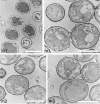Glycosylphosphatidylinositol-anchored Ecm33p influences conidial cell wall biosynthesis in Aspergillus fumigatus
- PMID: 16672465
- PMCID: PMC1472355
- DOI: 10.1128/AEM.72.5.3259-3267.2006
Glycosylphosphatidylinositol-anchored Ecm33p influences conidial cell wall biosynthesis in Aspergillus fumigatus
Abstract
ECM33 encodes a glycosylphosphatidylinositol-anchored protein whose orthologs in yeast are essential for sporulation. Aspergillus fumigatus Ecm33p is unique and has an apparent mass of 55 kDa. Disruption of A. fumigatus ECM33 results in a mutant with several morphogenetic aberrations, including the following: (i) a defect in conidial separation, (ii) an increase in the diameter of the conidia of the mutant associated with an increase in the concentration of the cell wall chitin, (iii) conidia that were sensitive to the absence of aeration during long-term storage, and (iv) conidia that were more resistant to killing by phagocytes, whereas the mycelium was more easily killed by neutrophils.
Figures







References
-
- Bernard, M., I. Mouyna, G. Dubreucq, J. P. Debeaupuis, T. Fontaine, C. Vorgias, C. Fuglsang, and J. P. Latgé. 2002. Characterization of a cell-wall acid phosphatase (PhoAp) in Aspergillus fumigatus. Microbiology 148:2819-2829. - PubMed
-
- Borgia, P. T., C. L. Dodge, L. E. Eagleton, and T. H. Adams. 1994. Bidirectional gene transfer between Aspergillus fumigatus and Aspergillus nidulans. FEMS Microbiol. Lett. 122:227-232. - PubMed
-
- Bruneau, J. M., T. Magnin, E. Tagat, R. Legrand, M. Bernard, M. Diaquin, C. Fudali, and J. P. Latgé. 2001. Proteome analysis of Aspergillus fumigatus identifies glycosylphosphatidylinositol-anchored proteins associated to the cell wall biosynthesis. Electrophoresis 22:2812-2823. - PubMed
-
- Cabib, E., D. H. Roh, M. Schmidt, L. B. Crotti, and A. Varma. 2001. The yeast cell wall and septum as paradigms of cell growth and morphogenesis. J. Cell Biol. 276:19679-19682. - PubMed
Publication types
MeSH terms
Substances
Grants and funding
LinkOut - more resources
Full Text Sources
Molecular Biology Databases

